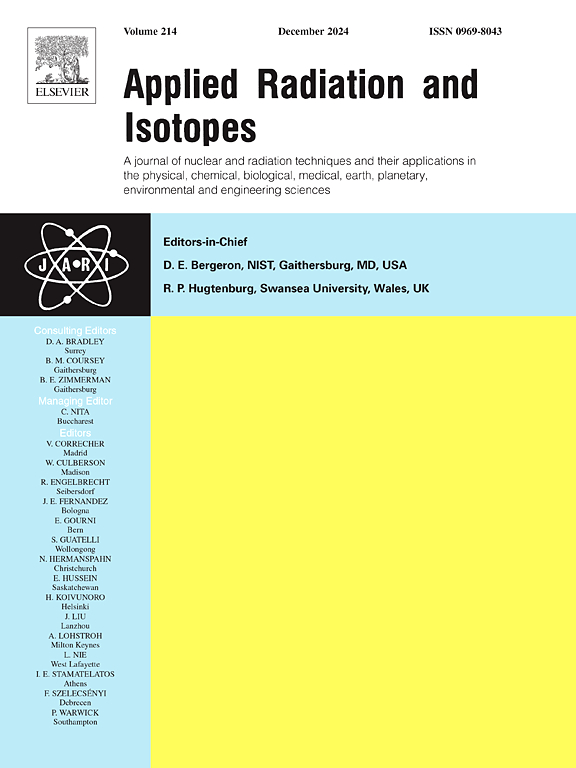Mapping sensitivity of CVD diamond detector using synchrotron micro-beam
IF 1.6
3区 工程技术
Q3 CHEMISTRY, INORGANIC & NUCLEAR
引用次数: 0
Abstract
In this project, we conducted micro-beam sensitivity mapping using the Diamond Light Source (DLS) synchrotron. We fabricated three samples with distinct metal contacts: Platinum (HPS-Pt) and Aluminium/Platinum (HPS-Al/Pt) on high-quality single crystal CVD diamond, and Platinum (VS-Pt) on lower purity single crystal CVD diamond. Our objective was to identify the most suitable sample for synchrotron measurements, particularly focusing on the lower purity sample due to its unique characteristics, such as thin nitrogen lines and substrate area.
High spatial resolution sensitivity maps were obtained for the lower purity sample using a micro step displacement of up to 10 μm, revealing detailed nitrogen lines. We observed that bias polarity significantly influenced the photocurrent, with negative bias yielding higher photocurrents, possibly due to polarisation effects. Near nitrogen lines, we noted a slow rise time and an increased stabilization time with bias, alongside a prolonged decay to dark current.
For the HPS-Al/Pt sample, we found no improvement in current response homogeneity, therefore reliability, with bias; instead, we recorded high dark currents and unstable signals, particularly at negative bias. Conversely, the HPS-Pt sample exhibited a uniform response at both +50V and −50V in the central region of the sensitivity maps. This response became increasingly homogeneous at 100V and further improved up to 200V, suggesting that HPS-Pt is the most suitable candidate for synchrotron measurements.
利用同步辐射微束绘制 CVD 金刚石探测器的灵敏度图
在本项目中,我们利用钻石光源 (DLS) 同步加速器进行了微光束灵敏度绘图。我们制作了三种具有不同金属触点的样品:高质量单晶 CVD 金刚石上的铂 (HPS-Pt) 和铝/铂 (HPS-Al/Pt) 以及较低纯度单晶 CVD 金刚石上的铂 (VS-Pt)。我们的目标是确定最适合进行同步辐射测量的样品,特别是低纯度样品,因为它具有独特的特性,例如氮线较细和基底面积较大。我们观察到,偏压极性对光电流有显著影响,负偏压产生较高的光电流,这可能是由于极化效应。对于 HPS-Al/Pt 样品,我们发现偏压并没有改善电流响应的均匀性,因此可靠性也没有提高;相反,我们记录到了较高的暗电流和不稳定的信号,尤其是在负偏压下。相反,HPS-Pt 样品在灵敏度图中央区域的 +50V 和 -50V 电压下均表现出一致的响应。这种响应在 100V 时变得越来越均匀,在 200V 时进一步改善,这表明 HPS-Pt 是最适合同步辐射测量的候选材料。
本文章由计算机程序翻译,如有差异,请以英文原文为准。
求助全文
约1分钟内获得全文
求助全文
来源期刊

Applied Radiation and Isotopes
工程技术-核科学技术
CiteScore
3.00
自引率
12.50%
发文量
406
审稿时长
13.5 months
期刊介绍:
Applied Radiation and Isotopes provides a high quality medium for the publication of substantial, original and scientific and technological papers on the development and peaceful application of nuclear, radiation and radionuclide techniques in chemistry, physics, biochemistry, biology, medicine, security, engineering and in the earth, planetary and environmental sciences, all including dosimetry. Nuclear techniques are defined in the broadest sense and both experimental and theoretical papers are welcome. They include the development and use of α- and β-particles, X-rays and γ-rays, neutrons and other nuclear particles and radiations from all sources, including radionuclides, synchrotron sources, cyclotrons and reactors and from the natural environment.
The journal aims to publish papers with significance to an international audience, containing substantial novelty and scientific impact. The Editors reserve the rights to reject, with or without external review, papers that do not meet these criteria.
Papers dealing with radiation processing, i.e., where radiation is used to bring about a biological, chemical or physical change in a material, should be directed to our sister journal Radiation Physics and Chemistry.
 求助内容:
求助内容: 应助结果提醒方式:
应助结果提醒方式:


